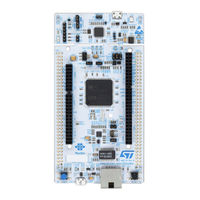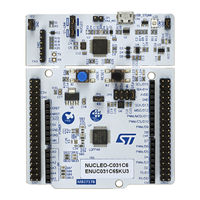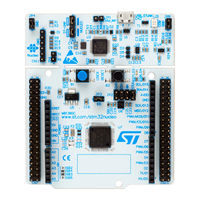ST STM32 Nucleo Manuals
Manuals and User Guides for ST STM32 Nucleo. We have 25 ST STM32 Nucleo manuals available for free PDF download: Programming Manual, User Manual, Application Note, Quick Start Manual
ST STM32 Nucleo Programming Manual (262 pages)
Brand: ST
|
Category: Computer Hardware
|
Size: 2 MB
Table of Contents
Advertisement
ST STM32 Nucleo User Manual (85 pages)
Nucleo-144 boards (MB1137)
Brand: ST
|
Category: Computer Hardware
|
Size: 2 MB
Table of Contents
ST STM32 Nucleo User Manual (68 pages)
Nucleo-64 boards
Brand: ST
|
Category: Motherboard
|
Size: 3 MB
Table of Contents
Advertisement
ST STM32 Nucleo User Manual (46 pages)
USB demonstration kit
Brand: ST
|
Category: Microcontrollers
|
Size: 2 MB
Table of Contents
ST STM32 Nucleo Application Note (49 pages)
How to get the best ADC accuracy in microcontrollers
Brand: ST
|
Category: Microcontrollers
|
Size: 1 MB
Table of Contents
ST STM32 Nucleo User Manual (55 pages)
Brand: ST
|
Category: Microcontrollers
|
Size: 1 MB
Table of Contents
ST STM32 Nucleo Application Note (26 pages)
Debug authentication (DA) for MCUs
Brand: ST
|
Category: Microcontrollers
|
Size: 1 MB
Table of Contents
ST STM32 Nucleo User Manual (32 pages)
Brand: ST
|
Category: Computer Hardware
|
Size: 2 MB
Table of Contents
ST STM32 Nucleo User Manual (39 pages)
Brand: ST
|
Category: Microcontrollers
|
Size: 5 MB
Table of Contents
ST STM32 Nucleo Application Note (31 pages)
microcontroller GPIO hardware settings and low-power consumption
Brand: ST
|
Category: Microcontrollers
|
Size: 0 MB
Table of Contents
ST STM32 Nucleo User Manual (31 pages)
Nucleo-64 board
Brand: ST
|
Category: Computer Hardware
|
Size: 1 MB
Table of Contents
ST STM32 Nucleo Application Note (28 pages)
Thermal management guidelines for applications
Brand: ST
|
Category: Microcontrollers
|
Size: 5 MB
Table of Contents
ST STM32 Nucleo User Manual (24 pages)
Brand: ST
|
Category: Microcontrollers
|
Size: 0 MB
Table of Contents
ST STM32 Nucleo User Manual (25 pages)
motor-control pack using the FOC algorithm for three-phase, low-voltage, and low‑current motor evaluation
Brand: ST
|
Category: Computer Hardware
|
Size: 5 MB
Table of Contents
ST STM32 Nucleo Application Note (18 pages)
ADC modes and their applications
Brand: ST
|
Category: Microcontrollers
|
Size: 0 MB
Table of Contents
ST STM32 Nucleo User Manual (33 pages)
based camera with ZigBee connectivity
Brand: ST
|
Category: Computer Hardware
|
Size: 2 MB
Table of Contents
ST STM32 Nucleo User Manual (27 pages)
Motor-control pack using the FOC algorithm for three-phase, low-voltage, and low-current motor evaluation
Brand: ST
|
Category: Control Unit
|
Size: 21 MB
Table of Contents
ST STM32 Nucleo User Manual (22 pages)
Discovery pack for LTE IoT cellular to cloud
Brand: ST
|
Category: Computer Hardware
|
Size: 0 MB
Table of Contents
ST STM32 Nucleo User Manual (22 pages)
Nucleo board software development tools
Brand: ST
|
Category: Motherboard
|
Size: 0 MB
Table of Contents
ST STM32 Nucleo User Manual (30 pages)
Brand: ST
|
Category: Computer Hardware
|
Size: 1 MB
Table of Contents
ST STM32 Nucleo Application Note (16 pages)
Getting started with Sensor expansion board
Brand: ST
|
Category: Motherboard
|
Size: 1 MB
Table of Contents
ST STM32 Nucleo User Manual (18 pages)
TCPM Application
Brand: ST
|
Category: Microcontrollers
|
Size: 0 MB
Table of Contents
ST STM32 Nucleo Quick Start Manual (31 pages)
Brand: ST
|
Category: Motherboard
|
Size: 2 MB
Table of Contents
ST STM32 Nucleo User Manual (14 pages)
How to use expansion board based on the STSAFE-A110 secure element
Brand: ST
|
Category: Computer Hardware
|
Size: 0 MB
Table of Contents
Advertisement
























